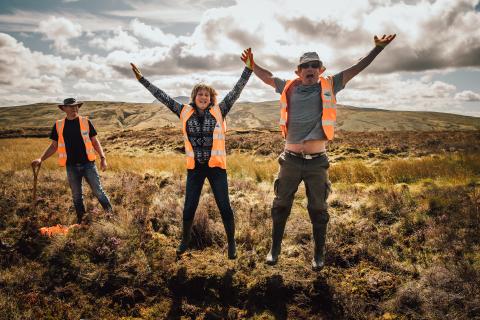Our peatlands act as a massive carbon store; but on the blanket bogs of Llwytmor and Foel-Grach on the Carneddau, large-scale erosion is risking releasing large amounts of carbon into our atmosphere and water courses. Now, thanks to funding from the Welsh Peatlands Sustainable Management Scheme (SMS) project and in collaboration with the National Trust and Aber and Llanfairfechan Graziers Society, peatland restoration work is about to commence on site.
Peatlands only cover 3% of the world’s surface, and yet they contain more than twice the carbon stored in all the forests across the world! Snowdonia National Park holds around 30% of Wales’ peatlands, with over 25,000 hectares of peat, and an estimated 17 million tonnes of carbon. The vast majority of these habitats are a globally rare type of peatland: ‘blanket bogs’ (upland peatlands ‘blanketing’ the hillsides).
Some 3500 hectares of these peatland habitats are found between the Carneddau peaks in the north of Snowdonia, with large blanket bogs on the slopes of Llwytmor and Foel-Grach. Historically, these peatlands have been heavily grazed which, when combined with the natural drainage off the mountains, has led to significant erosion and loss of carbon. Large peat ‘haggs’ – bare, cliff like formations that expose the underlying peat soil – have formed on the blanket bogs, draining the peat and triggering a huge release of greenhouse gases.
Nowadays, the mountain landscapes of the Carneddau are grazed at much lower levels, with protections in place for delicate montane habitats and, of course, the iconic Carneddau ponies. However, without further action to reverse the effects of erosion, these peatlands will continue to degrade. Llwytmor is one of the largest areas of eroded peatland of the Carneddau, therefore, this winter, work will be undertaken to re-vegetate vulnerable areas, slow the flow of water and restore the peatland. The work will greatly reduce the greenhouse gas losses as well as improving water storage in the surrounding peatland.
Peatlands are also a valuable storehouse of information as pollen and microfossils preserved in the peat tell us about past climates and vegetation, and how they have shaped our landscape. Under the Welsh Peatland Sustainable Management Scheme and future work by the Carneddau Landscape Partnership these peatlands will be restored in order to not only significantly reduce greenhouse gas losses but also safeguard evidence of the formation of our landscape.
Gareth Jones, Chair of the Aber and Llanfairfechan Graziers Society stated:
“As a Graziers Society we are very pleased to support the peatland restoration work that is about to commence on Llwytmor. Not only because of the environmental benefits of restoring peatland as a carbon store, but also to safeguard the landscape which is an important habitat for biodiversity, and not forgetting the wild Carneddau ponies that inhabit there.”
Rachel Harvey, the north Wales Project Officer for Welsh Peatlands Sustainable Management Scheme explained:
“Peatlands are meant to be really wet places: waterlogged soils have no oxygen to break down plant material, and this is how our peatlands have locked away so much carbon over the millennia. After historical peatland drainage and damage, this massive store of carbon is now being broken down and released in huge quantities as greenhouse gases. By restoring our peatlands, we’re working to re-wet them and putting a cap on this huge carbon loss.”
National Trust General Manager for Snowdonia and Llŷn, Trystan Edwards said:
“As a conservation charity, we’re restoring natural habitats in order to create healthy, resilient landscapes, and in particular focus on clean, natural watercourses. We’ve been able to share knowledge from similar restorative works on Y Migneint in the Upper Conwy catchment. Through the SMS project we’re working collaboratively to carry out this much needed restoration on the Carneddau.”
The Welsh Peatlands Sustainable Management Scheme is pan-Wales partnership project, led by Snowdonia National Park Authority, and funded through the Welsh Government Rural Communities – Rural Development Programme 2014-2020, which is funded by the Welsh Government and the European Union through the European Agricultural Fund for Rural Development (EAFRD).
Peatland restoration: Hagg Re-profiling:

